 10 January 2014, Maputo — Work on building the gas pipeline and distribution network that will supply natural gas to homes in Maputo is at an advanced stage, according to a press release from Mozambique’s National Hydrocarbons Company (ENH).
10 January 2014, Maputo — Work on building the gas pipeline and distribution network that will supply natural gas to homes in Maputo is at an advanced stage, according to a press release from Mozambique’s National Hydrocarbons Company (ENH).
The project is a partnership between ENH and Kogas of Korea, and is budgeted at 38.2 million US dollars. Work began in April 2013, and is now 60 per cent complete.
Currently a pressure reduction station (PRS) is being installed at the Maputo thermal power station, which will reduce the pressure of the gas from 43 bar to 10 bar, in line with the normal standards for the distribution of gas in urban centres.
The pipeline will be about 12 kilometres long, running from the city of Matola to the power station, while the distribution network will take the form of a ring about 60 kilometres long, serving the Maputo urban districts of KaMpfumo, Nlhamankulu and KaMubukwana.
The project seeks to maximize the local use of Mozambican natural gas extracted from Pande and Temane in Inhambane province by the South African petro-chemical giant, Sasol.
The ENH director for development projects, Paulino Gregoria, cited in the release, said this undertaking will reduce the import of liquid fuels, replacing them with Mozambican gas. This will have a direct impact on the balance of payments and on the gross domestic product.
“There will be a direct impact on the local economy with the use of natural gas in producing electricity, and in industry and transport”, he said.
The project will consume six million gigajoules of gas a year. Of this amount, 5.8 million gigajoules will be used by the electricity company EDM for the production and distribution of electricity in Maputo. The rest will be used for industry, hospitals, transport and domestic consumption.
The construction should be finished in June this year. ENH says the project is being undertaken in line with internationally recognised safety standards. Gas leak detectors are being installed along the pipeline route, and ENH envisages measures to educate the public about the safety measures required when using natural gas.



